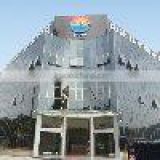SBS/APP modified waterproofing bitumen membrane
USD $2 - $5.5 /Square Meter
Min.Order:100 Square Meters
Quick Details View All >
China National Petroleum Waterproof (Shenzhen) Co., Ltd.
Product Details
JH-N100 SBS Modified Bituminous Waterproofing Membrane is a kind of macro-molecule material produced by advanced equipment and technology, using high-quality bitumen as its main component, Styrene-Butadiene-Styrene(SBS) as the modifier, superior materials as its reinforcement and many excellent materials as its isolating materials.
Low temperature resistance, high elongation ability, strong tensile strength, good abrasive resistance and easy to pave.
1. Industrial and civil roofing construction such as insulation roofs, planted roofs, roof parking lots and inverted roofs, etc.
2. Industrial and civil underground construction, indoor swimming pools, fire reservoirs, etc.
3. Tunnels, subways, concrete bridges, sewage plants and refuse landfills, etc.
4. Water conservancy facilities such as pools and water channels, etc.
Performance Standard GB 18242-2008
| Item | Index | |||||
| Ι | ΙΙ | |||||
| PY | G | PY | G | PYG | ||
| Content of Soluble Substance (G/m2) | 3mm | 2100 | ||||
| 4mm | 2900 | |||||
| 5mm | 3500 | |||||
| Heat Resistant | ºC | 90 | 105 | |||
| ≤mm | 2 | |||||
| Low Temperature Flexibility/ºC | -20 | -25 | ||||
| No Crack | ||||||
| Water Impermeability (30min) | 0.3MPa | 0.2MPa | 0.3MPa | |||
| Tension | Maximum Tension (N/50mm) ≥ | 500 | 350 | 800 | 500 | 900 |
| Secondly Maximum Tension (N/50mm) ≥ | 800 | |||||
| Elongation Rate | Maximum Elongation Rate / % ≥ | 30 | 40 | |||
| Maximum Elongation Rate / % ≥ | 15 | |||||
| Increased Quality After Immersion % ≤ | RE/S | 1.0 | ||||
| M | 2.0 | |||||
1, Torch-applied method and cold adhesion method are both feasible , or we can use these two methods together during the construction, which means cold adhesion method used at the main part and torch-applied method used at the seam.
2, Torch-applied method: use spray guns or blowtorches to heat the membrane and the base surface. While the bitumen on membranes is melting, roll the membrane forward, then use roller to make the membranes and the base surface stick together.
3, Cold adhesion method: brush adhesives on the base surface and membranes, after a while, pave the membranes, meanwhile press out the air with the roller until the membranes and the base surface stick together tightly and flat-wise.

Contact Supplier

You May Like



New Products
Popular Searches
Recommended Products
Find Similar Products By Category